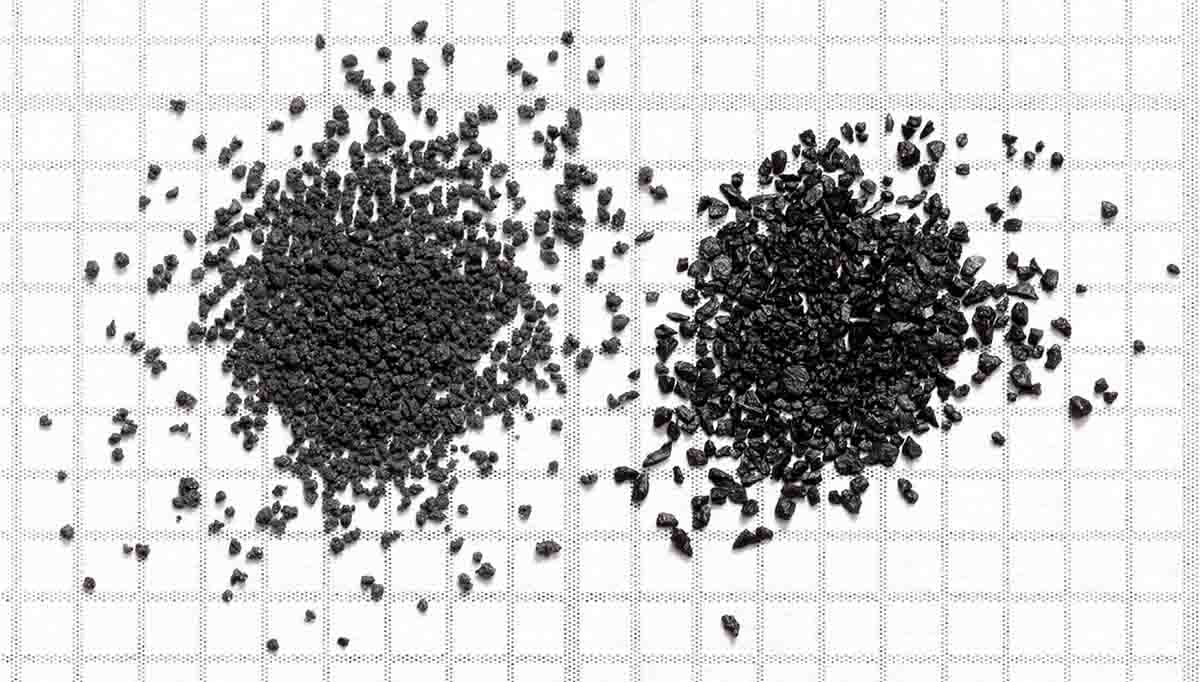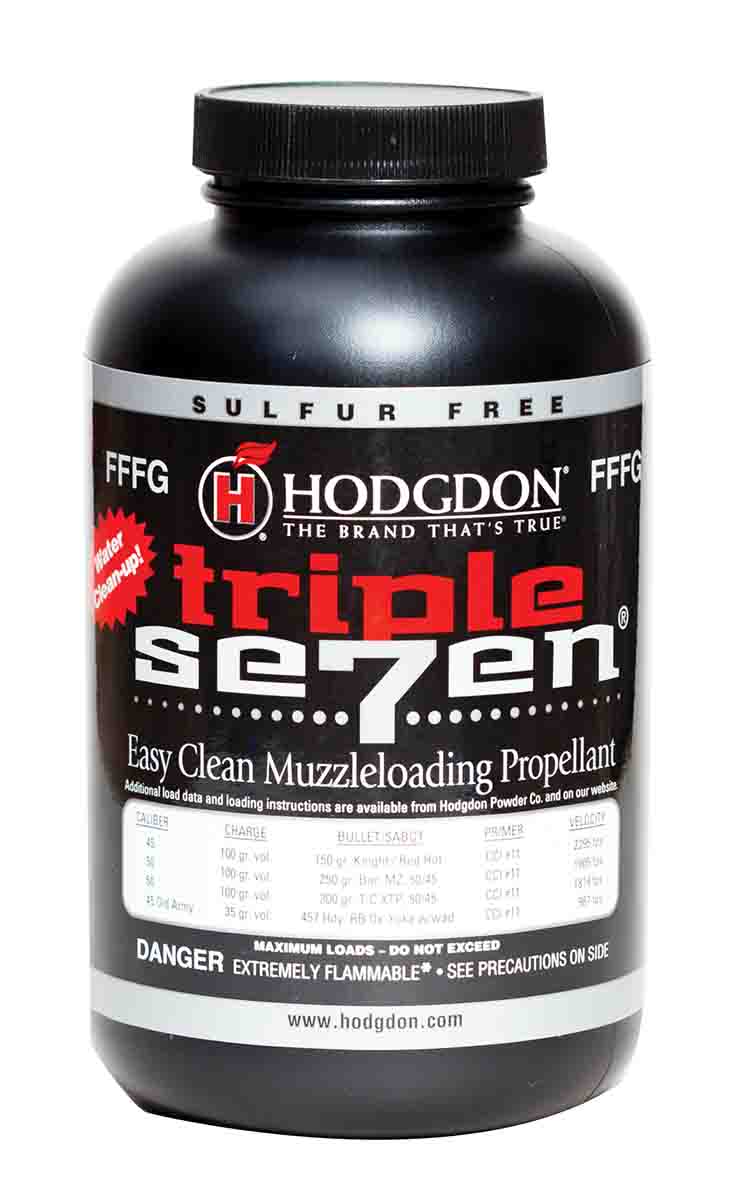Propellant Profiles
Hodgdon Triple Seven FFFg
column By: Randy Bimson | August, 21

In 1976, the U.S. celebrated its 200-year bicentennial and on May 17, 1976, Dan Pawlak and Hodgdon issued a press release introducing the first successful black-powder substitute propellant, Pyrodex. To state that Pyrodex was a game changer would be a gross understatement. Pyrodex challenged the 700-and-some-year-old dominance of black powder and changed the landscape of black-powder muzzleloading and cartridge firearm shooting forever.
Pyrodex dominated the substitute black-powder propellant market for 25 years, from 1976 until 2001, when Hodgdon introduced the Triple Seven family of black-powder substitute propellants. Triple Seven is now available as FFg and FFFg granular powder and five forms of pellets.

The physical characteristics and chemical makeup of Triple Seven FFFg is interesting. The powder granules are, as best as I could describe them, very fine and roughly semi-spherical in shape. The granules are a fairly consistent .005 inch to .009 inch across and best described as a darkish gray in color. The bulk density of Triple Seven FFFg is .75g/cc.
Chemically, the major elements of Triple Seven are 10 percent charcoal, 10 percent sodium benzoate, 30 percent potassium nitrate, 30 percent potassium perchlorate, 10 percent dicyanamide and 10 percent dextrin. Other elements of Triple Seven are proprietary information. The autoignition temperature of Triple Seven is 770 degrees Fahrenheit. Of special note is that it has been incorrectly stated in a number of instances in other shooting publications, in print and on the internet (Wikipedia), that Triple Seven uses gluconic acid (glucose or sugar-based) as the principal fuel source for the propellant. This is incorrect. Charcoal, as noted in the chemical composition above, is the principal fuel source for Triple Seven.
Also of note is that sulfur, a component of both black powder and Pyrodex, used to aid in the autoignition of the charcoal component upon firing, is absent in Triple Seven. While this does rid Triple Seven of the “rotten egg” odor often associated with both black powder and Pyrodex, it necessitates using a magnum-type 209 primer or percussion cap to ensure positive ignition.
In comparison, the pistol-grade Pyrodex P granules are best described as deep, black-colored, miniature coal-like lumps measuring from .007 inch to .013 inch, as best as I could measure across the widest measurable points. The bulk density of Pyrodex P is identical to Triple Seven FFFg at .75g/cc. The chemical composition does differ considerably, 15 to 40 percent potassium nitrate, 15 to 40 percent potassium perchlorate, 0.5 to 5 percent silica (crystalline, quartz), distillates (petroleum) 0.1 to 1 percent. Note that exact percentages are withheld as proprietary information. The auto-ignition temperature of granular Pyrodex is 740 degrees Fahrenheit. Unlike Triple Seven, Pyrodex does contain sulfur, which accounts for the lower autoignition temperature.
When stored under conditions favorable to virtually all propellant powders, cool and low humidity, Triple Seven and Pyrodex both exhibit exceptional shelf life. My reference sample of Triple Seven dates back to 2004 and the reference sample of Pyrodex to 2003.
Unlike Pyrodex, which has cartridge loading data available, Triple Seven FFFg grade is not recommended for use in loading any cartridge.
Shooting the Ruger Old Army in a side-by-side comparison with Pyrodex revealed some interesting findings and was a lot of fun to boot. When I first acquired my Ruger Old Army, I found it horribly unreliable using Pyrodex P. Regardless of percussion cap used, failures to fire averaged 99 percent. No fault of Pyrodex P. Changing out the OEM Ruger nipples for a set of Track of the Wolf’s excellent nipples has provided 100 percent ignition with either Pyrodex P or Triple Seven FFFg.
All testing for this article was conducted with 30 grains, by volume measure, of either Triple Seven FFFg or Pyrodex P, and as required, an Ox-Yoke .44/.45-caliber over-powder Wonder Wad was used with corn meal as a filler. Hornady .457-inch roundball and Remington No. 11 percussion caps were also used.
All loads where chronographed at 10 feet using an Oehler 35P chronograph. Loads were shot for accuracy at 20 yards from a bench and supported by an MTM pistol rest.
Velocities from the Old Army were pretty much as anticipated, with Triple Seven providing an average velocity of 929 feet per second (fps) and Pyrodex P an average velocity of 849 fps. On the other hand, both loads far and away exceeded my expectations. The standard deviation for six rounds of Triple Seven was 36 fps, and six rounds of Pyrodex was 8 fps. Quite frankly, I could hardly believe it and went back out another day and chronographed a 12-shot string of both loads. The average velocity of 12 rounds of Triple Seven was 931 fps and Pyrodex, 863 fps.
The uniformity of the velocity surely impacted the accuracy in a very positive way. Six rounds of the Triple Seven load cut one large, ragged hole at 1.113 inches, center-to-center, of the furthest most holes, and Pyrodex measured 1.302 inches.
From a cleanup perspective, Triple Seven was a delight to use, leaving a very light, grayish-colored film on the cylinder and forward half of the frame surrounding the cylinder window. Pyrodex, on the other hand, will definitely get your hands dirty. A thick, black, carbon- like film covered the cylinder almost from one end to the other; the lower part of the frame from the front of the cylinder window reward to a point on the side of the frame just in front of the trigger guard; and around the frame for about an inch or so forward of the cylinder face. After firing a combined total of 72 rounds without cleaning, the Ruger worked as freely as the first six-shot strings fired, indicating minimal buildup of fouling around the cylinder base-pin or hard fouling buildup on the cylinder face.
While the fouling left by Pyrodex is less corrosive than black-powder fouling, and Triple Seven is less corrosive than Pyrodex, both propellants still require reasonably prompt cleaning to ensure no corrosion damage to the firearm. Like Pyrodex, Triple Seven fouling can be removed with either plain water or a quality black-powder cleaning solvent.
In today’s world of hard-to-come-by centerfire components, a muzzleloader, and more specifically, a cap-and-ball revolver, may well satisfy your itch for some trigger time and even pass as a viable small-game hunting handgun. Like I have, shooters may find the local gun shops with Triple Seven or Pyrodex, and other muzzleloading components overlooked and still available to purchase right off the shelf. Give Triple Seven a try. I think you will be delighted, and oh, yes, Triple Seven does emit that whiff of smoke that goes hand in hand with a muzzleloader.



.jpg)